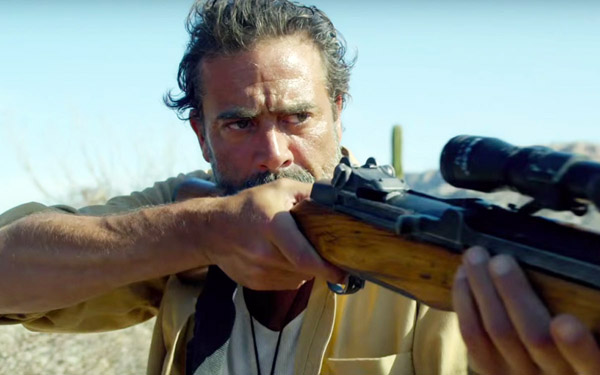One of the most divisive topics in America today is immigration, with an ever-widening gap between those who believe in building a wall to keep anyone different out, and those who believe in the country’s tradition of welcoming those of foreign lands.
Into this charged climate comes Desierto, a riveting thriller of non-stop action that also seizes the heart and mind and doesn’t let go. The film tells the tale of a handful of the desperate and undocumented, led by Gael Garcia Bernal, who risk their lives to cross from Mexico into the United States, only to wander into the crosshairs of an angry loner (Jeffrey Dean Morgan) on a personal vendetta, armed with a rifle and vicious hunting dog.
It’s a flip on the standard white man vigilante theme, thanks to Mexican writer-director Jonas Cuarón, the son of acclaimed filmmaker Alfonso Cuarón, with whom he co-wrote Gravity.
Jonas spoke with Creative Screenwriting about the treacherous path of his project from script to finished film.

Gael Garcia Bernal as Moises in Desierto
This film’s topic is as hot as the desert landscape itself. It feels like the film was written yesterday, but I believe that’s not the case?
No, I started working on this project ten years ago! I was traveling through Arizona, back when all these anti-immigration laws were being promoted. What I really admire about the U.S. is cultural diversity, so as someone who has lived in the U.S. since I was a teenager, I felt this need to write a story that spoke about this subject matter, about this hatred.
So I wrote this script, and then later, the first draft of the Desierto script ended up inspiring Gravity. My dad read that script and he became very interested in the concept, so we started adapting that concept to space.
So with that, and the fact that it was my first movie, I ended up taking ten years to finish the film.
I wrote Desierto with Mateo Garcia, my cousin, a writer I really admire. I was working on Gravity during the day with my dad, and then I would go at nights to work with Mateo on this screenplay.
After all that, you must have mixed feelings that it is as timely as ever.
Gael kept making fun of me, saying “You took so long that the movie’s not going to be relevant any more.” And the sad thing is that last year my wife showed me this video in which Donald Trump was saying incredibly racist things about migrants. That’s when I realized that the subject matter was not only still relevant, but was probably more relevant than before.

Gael Garcia Bernal as Moises and Alondra Hidalgo as Adela in Desierto
How did you settle on your approach?
For a couple years, I didn’t know the best approach. Then eight years ago I was watching Duel by Steven Spielberg, his first film, in which this truck is chasing a car for the whole movie. I was so amazed by how Spielberg not only managed, with such simple elements, to keep the audience glued to their seats, but also how without dialogue, the action of the movie ended up speaking about very important subject matter. Like the truck became a metaphor for a bully at school, for anything that’s oppressing.
A thriller is a great way to get a message across without alienating political sides.
When I wrote the film, it was supposed to be an allegory, a parable of where we can arrive as a society if we keep promoting so much hatred. My intention was never to be realistic. I kept assuming people were going to criticize the film for being far-fetched. The sad thing is that in the context it’s coming out, I no longer find the actions so far-fetched.

Dennis Weaver as David Mann in Duel
What have the reactions been like?
Well, the movie just opened in the U.S. so I still haven’t seen the response of the audience. What shocked me is that we published a trailer of Desierto last December, and if you go on the YouTube page of that trailer, it’s generated an incredible amount of racist comments.
Comments like, “I hope Jeffrey’s character kills them all. We should make the Mexicans pay for those bullets. That’s what happens when you come here illegally.”
What made me really sad is that I realize that all these political speeches have already pushed this rhetoric to a point where society has embraced it.
The film has drawn some criticism for its minimalist depiction of Jeffrey Dean Morgan’s character Sam, who seems to run his own private patrol of the border with his dog, his rifle and a bottle of whiskey.
I had a lot to say about Jeffrey’s character. I had a lot to say about Gael’s character. About all the other characters, about the odyssey of migration. But it’s a movie where ten minutes into it, it becomes non-stop action.
I did record many scenes with Jeffrey, which informed his character, but I always knew they weren’t going to be in the film because they went against the concept of the film. But those scenes informed Jeffrey. He makes it pretty clear that he’s not at the best economical moment. He has a drinking problem. The challenge was to try to find little symbols that would express a bigger story.

Jeffrey Dean Morgan as Sam in Desierto
That’s an often overlooked aspect of screenwriting – getting the characters down to the point where an actor is inspired to bring in their own creativity.
With Gael, when I first wrote the script his character was coming to the U.S. for the first time. But he has done so many documentaries on the issue of migration that he proposed to me a new backstory, which I immediately fell in love with, which was this idea that the character wasn’t coming to the U.S. for the first time, but he was returning.
I immediately fell in love with it because it’s not only The Odyssey, but thematically it helped push this idea of how arbitrary borders are, and how they sometimes go against the flow of human life.
This film takes place entirely in the desert wilderness, where scenes specifically rely on caves, ravines, rock formations – did you write the scenes and look for locations, or did locations shape and change scenes?
I had never been to a desert. So I wrote the first drafts based on YouTube videos of the desert, and basic research I did on the computer. After I finished those first drafts, I did get the opportunity to start travelling a lot to the desert, and those trips started informing a lot of the screenplay.

Gael Garcia Bernal as Moises in Desierto
What changes did you have to make?
I showed the screenplay to filmmaker Alejandro González Iñárritu, and the only note that he gave me is to be very careful with space between characters.
I didn’t understand what he meant until I was on the location. You don’t want it to be too close that it would make no sense that Gael’s character doesn’t get killed. But you don’t want it to be too far away so it’s not threatening.
An example is where Gael is stealing the truck. Originally in the screenplay, that was all in a really flat valley, but I realized it would be useful for Jeffrey to be on higher ground to explain why it takes so long for him to reach the truck.
The only location that I ended up changing was the final chase. In the screenplay it’s in what’s called a slot canyon, like the one in 127 Hours. But every day on my way to shooting, I kept seeing these really impressive mountains in the distance. It became more interesting to have our main character go up the mountain and confront the monster once he makes it to the top. Reality is way more impressive than anything you can imagine.
You co-wrote Gravity with your father Alfonso, and you’ve said that Desierto actually inspired Gravity. How on earth did that come about?
I always joke with my dad that Desierto is the grounded version of Gravity. I showed my dad a first draft of Desierto, and we started talking about different films with the same concept, like Duel and Runaway Train and Vanishing Point. So that conversation led to us working on Gravity.
Both films stem from the same concept, but because the environments are so different, the stories became very different. In Gravity, the environment was space; the thematic conversation became an existential one. In Desierto the conflict was in the desert, which has important geopolitical significance, and the story became an exploration of migration.

Sandra Bullock as Dr. Ryan Stone in Gravity. Photo by Courtesy of Warner Bros. Picture – © 2013 Warner Bros. Entertainment Inc.
What was it like writing with your father? Did you sit in the same room, trade pages?
It was a nice because it gave us the excuse to spend a full year together. Because I have worked with computers longer, maybe I did most of the typing!
What was the biggest thing you learned in that process?
We approached it as naive screenwriters, and not filmmakers. I think if my dad had foreseen all the challenges he was going to have as a director, he would have stopped writing two pages into it. But we never thought of how difficult it was going to be to film. We just literally sat every day and imagined the scene just how we wanted it.
So my approach with Mateo was very similar to Gravity. Just imagining the movie we wanted to make.
Featured image: Jeffrey Dean Morgan as Sam in Desierto
[addtoany]

